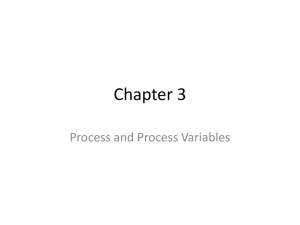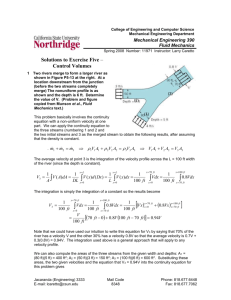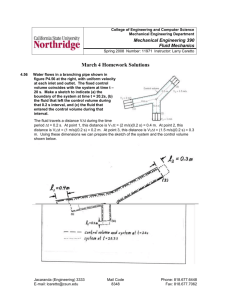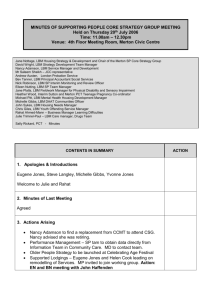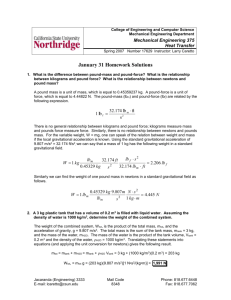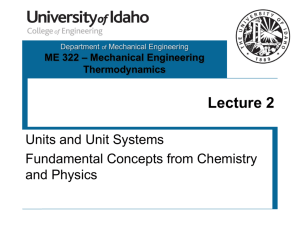Kinetic Theory and Lattice Boltzmann Models for Multiphase Flows
advertisement
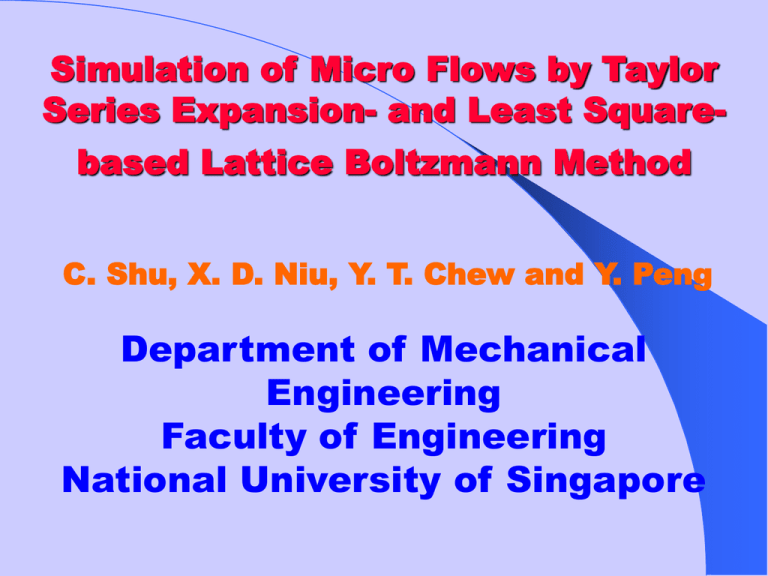
Simulation of Micro Flows by Taylor
Series Expansion- and Least Square-
based Lattice Boltzmann Method
C. Shu, X. D. Niu, Y. T. Chew and Y. Peng
Department of Mechanical
Engineering
Faculty of Engineering
National University of Singapore
Outline
Introduction
Standard Lattice Boltzmann
method (LBM)
TLLBM for Non-uniform Mesh
and Complex geometries
TLLBM for Micro Flows
Numerical Examples
Conclusions
1. Introduction
Micro Flows in MEMS
Classification of Flow Regimes
according to Knudsen number
0.001
3 (10)
0.1
Continuum Flow
Transition Regime
(Ordinary Density Levels)
(Moderately Rarefied)
Kn
L
100
Slip-Flow Regime
Free-Molecule Flow
(Slightly Rarefied)
(Highly rarefied)
Ma
2 Re
1
2n 2
Studies of Micro Flows
– Experimental
– Numerical and Theoretical
Navier-Stokes Solver with Slip
Condition
– Only applicable to slip flow regime
Particle-based Methods
– MD (Molecular Dynamics)
– DSMC (Direct Simulation Monte Carlo)
– Applicable to slip flow and transition
regimes
– Huge computational effort
Demanding More Efficient Solver for
Micro Flow Simulation
• Does LBM have Potential to be
an Efficient Method?
LBM is also a particle-based method
Features of LBM and MD, DSMC
Micromechanics of real particles by MD
and DSMC; micromechanics of fictitious
particles by LBM
Local conservation laws are satisfied by
all
Tracking particles by MD and DSMC
(Lagrangian solver); Dynamics of particles
at a physical position and a given velocity
direction by LBM (Eulerian solver)
LBM More efficient than MD and DSMC
2. Standard Lattice Boltzmann
Method (LBM)
Particle-based Method (streaming &
collision)
D2Q9
Model
Streaming process
Collision process
Isothermal Flows:
f ( x ext , y eyt , t t ) f ( x, y, t )
[ feq ( x, y, t ) f ( x, y, t )] /
feq
1 1 e U e U 2 U 2
2 2 4 2 2
c
c
2 6 c
N
f
0
N
U f e
0
(2 1) 2
c t
P c / 2
8
2
Thermal Flows
o Difficulty (stability and fixed Pr)
o A number of thermal models
available
Multi-speed model; Hybrid model; two
distributions model (passive scalar;
IEDDF)
o We prefer to use IEDDF for the
thermal flows (He et al. 1998)
f (mass) is used for velocity field
g (energy) is used for temperature field
Features of Standard LBM
o Particle-based method
o Density distribution function as
dependent variable
o Explicit updating; Algebraic
operation; Easy implementation
No solution of differential equations
and resultant algebraic equations is
involved
o Natural for parallel computing
Limitation---Difficult for
complex
geometry and
non-uniform mesh
Mesh points
Positions from streaming
3. TLLBM for Non-uniform
Mesh and Complex Geometry
Current LBM Methods for Complex
Problems
o Interpolation-Supplemented LBM
(ISLBM)
He et al. (1996), JCP
Features of ISLBM
Large computational effort
May not satisfy conservation
Laws at mesh points
Upwind interpolation is needed
for stability
Mesh points
Positions from streaming
o
Differential LBM
Taylor series expansion to 1st order
derivatives
f
f
f f eq ( x, y, t ) f ( x, y, t )
ex
ey
t
x
y
t
Features:
Wave-like equation
Solved by FD and FV methods
Artificial viscosity is too large at high Re
Lose primary advantage of standard LBM
(solve PDE and resultant algebraic
equations)
• Development of TLLBM
o
Taylor series expansion
f ( P , t t )
f ( P , t t )
f ( A, t t ) f ( P , t t ) x A
y A
x
y
2
2
1
1
2 f ( P , t t )
2 f ( P , t t )
(x A )
(y A )
2
2
2
x
2
y
2 f ( P , t t )
x A y A
O[( x A ) 3 , (y A ) 3 ]
xy
P-----Green (objective point)
A----Red (neighboring point)
Drawback: valuation
of Derivatives
o
Idea of Runge-Kutta Method
(RKM)
du
dt
f (u, t ),
u u0 , when t 0
Taylor series method:
n
n+1
2
3
du
1
d
u
1
d
u
n 1
n
2
3
u u h
h
h
, h t
2
3
dt 2 dt
6 dt
Need to evaluate high order
derivatives
Runge-Kutta method:
n
Apply Taylor series expansion at
Points to form an equation system
n+1
Taylor series expansion is applied at 6
neighbouring points to form an
algebraic equation system
A matrix formulation obtained:
o
[ S ]{V } {g}
(*)
{V } { f , f / x, f / y, f / x , f / y, f / xy}
2
{g} {g i }
Tg
i
f ( xi , yi , t )
2
2
2
2
eq
f ( xi , yi , t ) f ( xi , yi , t )
[S] is a 6x6 matrix and only depends the geometric
coordinates (calculated in advance in programming)
T
/
o Least Square Optimization
Equation system (*) may be ill-conditioned or
singular (e.g. Point coincide)
Square sum of errors
E
M
2
erri
i 0
g i si , jV j
i 0
j 1
M
6
2
i 0,1,2,..., M ( M 5 for 2 D)
M is the number of neighbouring points used
Minimize error:
E / Vk 0, k 1,2,...,6
Least Square Method (continue)
The final matrix form:
1
{V } [ S ] [ S ] [ S ] {g} [ A]{g}
T
T
[A] is a 6(M+1) matrix
The final explicit algebraic form:
M 1
f ( x0 , y0 , t t ) a1,k gk 1
k 1
(Shu et al. 2002
PRE, Vol 65)
are the elements of the first row of
a1,k the
matrix [A] (pre-computed in
program)
Features of TLLBM
o Keep all advantages of standard
LBM
o Mesh-free
o Applicable to any complex
geometry
o Easy application to different
lattice models
Flow Chart of Computation
Input , U , Re, e
M 1
f ( x0 , y0 , t t ) a1,k gk 1
k 1
Calculating Geometric Parameter
and physical parameters
( a1, k , N=0 )
N=N+1
M
M
0
0
f U f e
No
Convergence ?
Calculating
eq
f
YES
OUTPUT
Boundary Treatment
Bounce back from the wall
Fluid Field
Stream from fluid field
f f
Non-slip condition is exactly satisfied
Square Driven Cavity (Re=10,000,
Non-uniform mesh 145x145)
Streamlines (right) and Vorticity contour (left)
4. TLLBM for Micro Flows
LBM for macro flows
is related to viscosity (m) through
Chapman-Enskog expansion
Bounce back rule (non-slip condition)
Features of micro flows
Knudsen number (Kn) dominant
Velocity slip at wall
Temperature jump at wall
LBM for micro flows
m relationship not valid. kn ?
Bounce back rule not valid. New B. C. ?
• Relationship of -Kn
In Kinetic Theory:
Relaxation time in velocity field:
f
m
P
Relaxation time in thermal field:
g
m
Pr P
(Pr m c p / ; c p R /( 1); 5 / 3)
Knudsen number:
Ma
Kn
L
2 Re
• Relationship of -Kn
In LBM:
Mach number and Reynolds number:
Ma
Re
U ref
cs
U ref H
m
We derived:
f H Kn
H Kn
g
Pr
(cs 1 / 3 )
• Boundary Conditions For Micro Flows
n
Specular boundary condition
Fluid
Wall
Diffuse-Scattering Boundary Condition (DSBC)
Kinetic Theory:
(ξ u w ) n f (ξ )
(ξ
'
u w ) n (ξ ' ξ ) f (ξ ' ) dξ '
( ξ ' u w )n 0
Maxwell Kernel:
(ξ u w ) n
(ξ u w ) 2
(ξ ξ )
exp(
)
2 RTw
2 ( RTw ) 2
1
'
w (2RTw
2 D
) 2
((ξ u w ) n) f
eq
(ξ )
u u w
RTw
Normalized condition:
'
(
)d 1
( u w ) n 0
(( ' u w ) n 0)
(incoming mass flux
Equals to outgoing
Mass flux)
LBM Version
Replace integral by summation
(e u w ) n f
( e ' u w ) n 0
(e u w ) n g
f (e ' e )
g (e ' e )
AN 6
(e ' u w ) n f (e ' e ) f '
BN
(e ' u w ) n g (e '
( e ' u w )n 0
AN
w
w
((e u w ) n) f eq
((e u w ) n) geq
BN 3 ( D2Q9)
e ) g '
u u w
u u w , W
Theoretical analysis of DSBC--a 2D
constant density flow along an
infinite plate with a moving velocity
and a temperature
u Kn 2 u
U S u w U 0 Kn
2
n
2 n
Kn T Kn 2T
TS Tw T0
2
Pr n 2 Pr n
5. Numerical Examples
High pressure
Low pressure
Pressure-Driven, Isothermal Micro Channel Flow
U*
0.3
0.2
0.1
0.5
1
0.25
0
0.75
0
0.5
Y
-0.25
0.25
-0.5
0
X
Kn=0.05
Pr=2.0
Pressure-Driven, Isothermal Micro Channel Flow
0.002
0.001
V*
0
-0.001
-0.002
0.4
0
0.2
0.2
0
0.4
X
0.6
Y
-0.2
0.8
-0.4
1
Kn=0.05
Pr=2.0
Non-linear Pressure Distribution along the Channel
Kn=0.056, Pr=1.88
0.05
P'
0.025
Arkilic
Spec.
U. Ext.
UCLA
0
0
0.25
0.5
X
0.75
1
Non-linear Pressure Distribution along the Channel
Kn=0.155, Pr=2.05
0.05
P'
0.025
0
Arkilic
Spec.
U. Ext.
UCLA
0
0.25
0.5 X
0.75
1
Pressure-Driven Microchannel Flows
Kn=0.053
Kn=0.165
Mass Flow(Kg/s)
Mass Flow(Kg/s)
5
1.2
Exe. data, Argon [23]
1
No-Slip
0.8
Present LBM
Exe. data, Helium [24]
4
3.5
No-Slip
Analytical [23]
Present LBM
3
Analytical [23]
0.6
4.5
2.5
2
0.4
1.5
1
0.2
0.5
0
0
1
1.5
2
2.5
3
3.5
4
Pressure ratio
4.5
5
1
1.5
2
2.5
Pressure ratio
3
Comparison of slip magnitude at wall in
the slip flow regime (shear-driven flow)
Kn
Analytic
LBM
0.001
0.000998
0.0008628
0.00167
0.001667
0.0015939
0.002
0.001990
0.0019277
0.004
0.003968
0.0039492
0.005
0.004950
0.0049355
0.01
0.009800
0.0097963
0.02
0.019231
0.0192269
0.025
0.023800
0.0238064
0.03
0.028302
0.0280455
0.04
0.037037
0.0370351
0.05
0.045400
0.0454530
0.1
0.083300
0.0833333
Thermal Couette Flow
High T
Low T
2
1
T
U
0.5
1.5
0
1
No-Slip
No-Slip
Kn=0.05
Kn=0.1
Kn=0.3
LBM(Kn=0.05)
-0.5
LBM(Kn=0.1)
0.5
LBM(Kn=0.3)
-1
-0.5
-0.25
Y
0
Velocity Profile
0.25
0.5
0
-0.5
-0.25
Y
0
0.25
Temperature Profile (Ec =10)
0.5
Slip length
Temperature Jump
1.2
Ls
0.8
2.5
Present LBM
Maxwel [19]
MD [20]
DSMC [20]
Lj
2
Present LBM
Maxwell [19]
1.5
1
0.4
0.5
0
0.01
0.1
Kn
1
0
0.01
0.1
Kn
1
Thermal Developing Flow
(Constant Temperature on the walls Tw=10Tin)
Temperature
Z
Y
velocity
Z
Y
X
X
10
U1.5
20
1
5
15
0.5
10
x/H
0.5
5
0
y/H
-0.5 0
20
15
0.5
0.25
y/H
10
0
-0.25
-0.5 0
5
x/H
Thermal Developing Flow
Thermal developing Channel flow---Wall
coefficients along channel
55
18
Kn=0.015
Cf*Re
Kn=0.03
45
Nu
Kn=0.015
15
Kn=0.03
Kn=0.046
Kn=0.046
35
12
25
9
15
6
0.1
1
x/H
10
0.1
1
x/H
10
Thin Film Gas Slider Bearing
Lubrication
y
6mU w L / P0 H
x
2
0
x=0
x=L
Knudsen Number, Kn
0.8
2nd-order model
0.7
10
P
0.6
Load Carrying Capacity, W
stress-density ratio model
LBM
0.5
0.4
0.3
0.2
0.1
0
0
0.2
0.4
X/L
0.6
Kn=1.24, =123.2
1
10
10
0
10
=10
10-1
Boltzmann
10-2
10
0.8
0
1
Continuum
stress-density ratio model
second-order model
LBM
-3
10-1
100
Inverse Knudsen Number, D
-1
Three-dimensional Thermal
Developing Flow in Ducts
Constant Heat flux at the wall;
Initial flow is assumed static with a
constant temperature;
Re=0.1, Pr=0.7
Z
Y
H
Flow
W
L
X
Three-dimensional Thermal
Developing Flow in Ducts
Z
Y
X
.
0.5
Velocity distribution along duct
Kn 0.06
Z
Y
1.0462
1.0240
1.0110
1.0055
1.0037
1.0010
0.9998
0.9989
0.9979
X
Thermal distribution along duct
Velocity profile at different cross
sections
Z
X
Z
Y
X
1.5
Y
1.5
1
-0.5
-0.25
-0.125
z /w 0
0.125
0.25
-0.25
0.25
u/U0
u/U0
1
0.5
0 w
y/
0.5
0.5
-0.5
-0.25
-0.125
z /w 0
0.125
0.25
-0.25
0.25
0 w
y/
0.5
x=0.3442
x=0.0
Z
Z
X
X
Y
Y
1.5
1.5
1
u/U0
0.5
-0.5
-0.25
-0.125
z /w 0
0.125
0.25
-0.25
0.25
0.5
x=0.7826
0 w
y/
u/U0
1
0.5
-0.5
-0.25
-0.125
z /w 0
0.125
0.25
-0.25
0.25
0.5
x=1.230
0 w
y/
Temperature profile at different
cross sections
Z
X
Z
Y
X
1.5
Y
1.5
1
1
-0.5
-0.25
-0.125
z /w 0
0.125
0.25
-0.25
0.25
T/T0
T/T0
0.5
0 w
y/
0.5
0.5
-0.5
-0.25
-0.125
z /w 0
0.125
0.25
x=0.0
-0.25
0.25
0 w
y/
0.5
x=0.3442
Z
Z
X
X
Y
1.5
1.5
1
1
-0.5
-0.25
-0.125
z /w 0
0.125
0.25
-0.25
0.25
0.5
x=0.7826
0 w
y/
T/T0
T/T0
0.5
0.5
Y
-0.5
-0.25
-0.125
z /w 0
0.125
0.25
-0.25
0.25
0.5
x=1.230
0 w
y/
Three-dimensional Thermal
Developing Flow in Ducts: Comparison
Kn 0.04
Nu
Us
Slip model
Present
Slip model
Present
1
0.21
0.25
2.85
3.16
0.75
0.25
0.27
2.81
3.06
0.5
0.32
0.30
2.71
2.92
Kn 0.06
1
0.28
0.31
2.69
2.87
0.75
0.33
0.33
2.62
2.79
0.5
0.41
0.36
2.48
2.66
1
0.34
0.37
2.53
2.60
0.75
0.39
0.38
2.44
2.54
0.5
0.48
0.41
2.26
2.44
Kn 0.08
6. Conclusions
TLLBM is an efficient method for
simulation of different micro flows
New relationship of -Kn is valid
Specular and diffuse-scattering
boundary conditions can capture
velocity slip and temperature jump
Not accurate for cases with high
pressure ratio (an incompressible
model)
